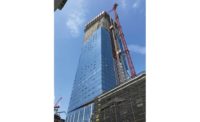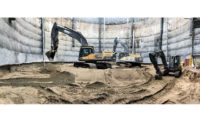Humboldt Bay Power Plant Decommissioning - Caisson Removal
Eureka, Calif.
Best Project
Owner: Pacific Gas and Electric Co.
Lead Design Firm: McMillen Jacobs
General Contractor/Civil Engineer: APTIM
Structural Engineer: Geosyntec Consultants Inc.
The decommissioning process at Pacific Gas and Electric’s Humboldt Bay nuclear power plant, built in the 1960s, required painstaking excavations. The project team also had to deal with challenging ground conditions and the plant’s proximity to the Pacific Ocean.
The 18-month project involved removing a 4-ft-thick concrete cylinder, or reactor caisson, from 80 ft under the ground. The team had originally planned to build a cement slurry wall around the plant’s refuel building and turbine building to keep the groundwater out. Plans also called for a soil nail wall as well as a sheet pile wall and ring beam shoring system to support the caisson during excavation. This approach would have required demolition of all the buildings on the site, says Alan Brown, project engineer at APTIM, the project’s general contractor and civil engineer.
While conducting the geotechnical study for the slurry wall, APTIM learned that the clay layer below the site was continuous throughout the area and 20-25 ft thick, Brown says. This discovery helped support an alternative plan using Cutter Soil Mix (CSM) technology, which would support the excavation while preventing groundwater infiltration. Workers using CSM operate equipment with rotating wheels to cut the surrounding soil while blending in the cement slurry with soil to form soil cement panels. The team used 255 overlapping panels to build a 13-ft-thick compression ring, with the outermost panels mixed to a depth of 174 ft to tie into the clay layer. This formed the base for a water cut-off barrier.
“With CSM, we were able to use the existing topography rather than build the slurry wall around the turbine building,” Brown says. “Basically, we made a bathtub out of the clay layer.”
Water still remained a constant concern within the 110-ft-dia excavation site, Brown says. The nuclear plant was built on clay layers and fine, silty sands with the groundwater table only 5 ft down. But the ring of CSM panels formed an effective barrier. “Everybody thought if you dig a hole 6 ft deep, you’ll get a flood of water, but as long as you didn’t dig below the clay layer, you were fine,” Brown says.
The team repeatedly tested the groundwater inflow into the site, with good results: a “miniscule” 17 gallons of water per minute, he says. Once the caisson was removed and before the crews began backfilling, the team tested the inflow again by a different method. The result: essentially the same at 20 gallons of water per minute.
While the team had confidence in the expanded CSM methods used, the Humboldt Bay project pushed the limits of the technology, Brown says. “It’s one thing to have a gut feeling, and have a 20-page calculation to show you can do it, but it’s another thing to actually go out and do it.”
Back to "ENR California Best Projects 2018: Region's Best Work Shines With Creativity"








Post a comment to this article
Report Abusive Comment